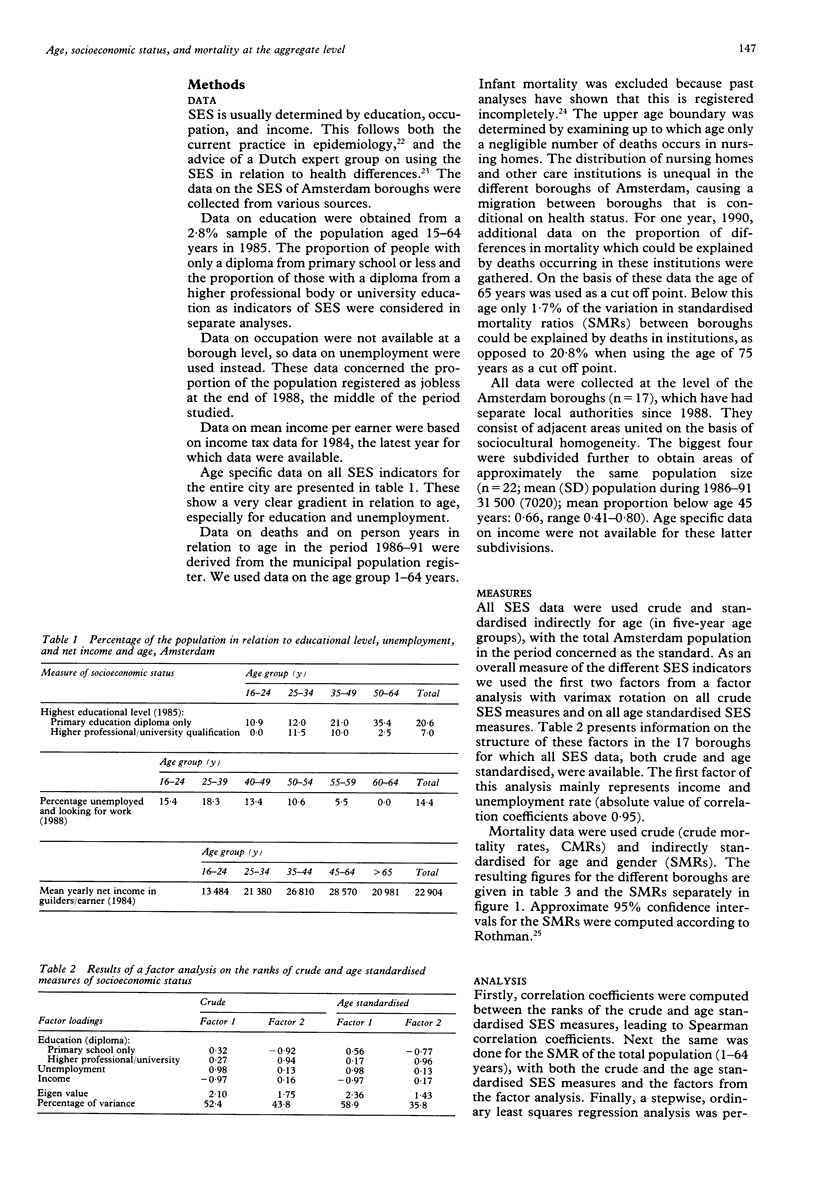Abstract
STUDY OBJECTIVE--Indicators of socioeconomic status are associated with age. This study aimed to analyse the influence of the age distribution on the ranking of small areas by socioeconomic status and on the association between their socioeconomic status and standardised mortality. DESIGN--The ranking of small areas by socioeconomic status indicators (educational level, income, and unemployment) was compared with crude values and after correction for their age structure. The age and gender standardised mortality ratios (SMRs) of these areas for the age group 1-64 years was then rank correlated with both crude and age standardised measures of socioeconomic status. SETTING--This study used data for all (n = 22) boroughs of Amsterdam for the period 1986-91. MAIN RESULTS--Correction of indicators of socioeconomic status for the age structure of the population hardly affects the ranking of Amsterdam boroughs by socioeconomic status. All rank correlations between crude and age standardised socioeconomic status measures are above 0.95. Rank correlations between SMR and these socioeconomic status measures also hardly change after correction for the age structure of boroughs except for education. Mean income per earner is the socioeconomic status indicator most strongly associated with the SMR. CONCLUSIONS--This study shows that the age structure of Amsterdam boroughs has almost no influence on their ranking by socioeconomic status and a limited influence on the association between their socioeconomic status and SMR, except for educational level. The latter indicator has the strongest association with age. This result and theoretical considerations indicate that a correction for the age structure of the population will be more important if small areas differ little with regard to socioeconomic status, if they vary considerably in age structure, or if a given indicator of socioeconomic status shows a strong cohort effect or age association.
Full text
PDF




Selected References
These references are in PubMed. This may not be the complete list of references from this article.
- Ben-Shlomo Y., White I., McKeigue P. M. Prediction of general practice workload from census based social deprivation scores. J Epidemiol Community Health. 1992 Oct;46(5):532–536. doi: 10.1136/jech.46.5.532. [DOI] [PMC free article] [PubMed] [Google Scholar]
- Brennan M. E., Lancashire R. Association of childhood mortality with housing status and unemployment. J Epidemiol Community Health. 1978 Mar;32(1):28–33. doi: 10.1136/jech.32.1.28. [DOI] [PMC free article] [PubMed] [Google Scholar]
- Jarman B. Identification of underprivileged areas. Br Med J (Clin Res Ed) 1983 May 28;286(6379):1705–1709. doi: 10.1136/bmj.286.6379.1705. [DOI] [PMC free article] [PubMed] [Google Scholar]
- Kunst A. E., Looman C. W., Mackenbach J. P. Socio-economic mortality differences in The Netherlands in 1950-1984: a regional study of cause-specific mortality. Soc Sci Med. 1990;31(2):141–152. doi: 10.1016/0277-9536(90)90055-w. [DOI] [PubMed] [Google Scholar]
- Liberatos P., Link B. G., Kelsey J. L. The measurement of social class in epidemiology. Epidemiol Rev. 1988;10:87–121. doi: 10.1093/oxfordjournals.epirev.a036030. [DOI] [PubMed] [Google Scholar]
- Mackenbach J. P., Kunst A. E., Looman C. W. Cultural and economic determinants of geographical mortality patterns in The Netherlands. J Epidemiol Community Health. 1991 Sep;45(3):231–237. doi: 10.1136/jech.45.3.231. [DOI] [PMC free article] [PubMed] [Google Scholar]
- Morgenstern H. Uses of ecologic analysis in epidemiologic research. Am J Public Health. 1982 Dec;72(12):1336–1344. doi: 10.2105/ajph.72.12.1336. [DOI] [PMC free article] [PubMed] [Google Scholar]
- Morris R., Carstairs V. Which deprivation? A comparison of selected deprivation indexes. J Public Health Med. 1991 Nov;13(4):318–326. [PubMed] [Google Scholar]
- Piantadosi S., Byar D. P., Green S. B. The ecological fallacy. Am J Epidemiol. 1988 May;127(5):893–904. doi: 10.1093/oxfordjournals.aje.a114892. [DOI] [PubMed] [Google Scholar]
- Smith G. D., Bartley M., Blane D. The Black report on socioeconomic inequalities in health 10 years on. BMJ. 1990 Aug 18;301(6748):373–377. doi: 10.1136/bmj.301.6748.373. [DOI] [PMC free article] [PubMed] [Google Scholar]
- Smith G. D. Second thoughts on the Jarman index. BMJ. 1991 Feb 16;302(6773):359–360. doi: 10.1136/bmj.302.6773.359. [DOI] [PMC free article] [PubMed] [Google Scholar]
- Townsend P., Simpson D., Tibbs N. Inequalities in health in the city of Bristol: a preliminary review of statistical evidence. Int J Health Serv. 1985;15(4):637–663. doi: 10.2190/AN09-8R52-UE6B-VWUU. [DOI] [PubMed] [Google Scholar]
- Whitehead M., Dahlgren G. What can be done about inequalities in health? Lancet. 1991 Oct 26;338(8774):1059–1063. doi: 10.1016/0140-6736(91)91911-d. [DOI] [PubMed] [Google Scholar]


